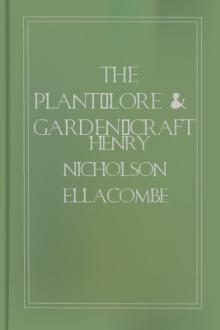The plant-lore & garden-craft of Shakespear, Henry Nicholson Ellacombe [read with me .TXT] 📗

- Author: Henry Nicholson Ellacombe
- Performer: -
Book online «The plant-lore & garden-craft of Shakespear, Henry Nicholson Ellacombe [read with me .TXT] 📗». Author Henry Nicholson Ellacombe
[223:1] "We usually think of the Poppy as a coarse flower; but it is the most transparent and delicate of all the blossoms of the field. The rest, nearly all of them, depend on the texture of their surface for colour. But the Poppy is painted glass; it never glows so brightly as when the sun shines through it. Wherever it is seen, against the light or with the light, always it is a flame, and warms the wind like a blown ruby."—Ruskin, Proserpina, p. 86.
POTATO. (1) Thersites. How the devil Luxury, with his fat rump and Potato-finger, tickles these together. Troilus and Cressida, act v, sc. 2 (55). (2) Falstaff. Let the sky rain Potatoes; let it thunder to the tune of Green Sleeves, hail kissing-comfits, and snow Eringoes. Merry Wives of Windsor, act v, sc. 5 (20).The chief interest in these two passages is that they contain almost the earliest notice of Potatoes after their introduction into England. The generally received account is that they were introduced into Ireland in 1584 by Sir Walter Raleigh, and from thence brought into England; but the year of their first planting in England is not recorded. They are not mentioned by Lyte in 1586. Gerard grew them in 1597, but only as curiosities, under the name of Virginian Potatoes (Battata Virginianorum and Pappas), to distinguish them from the Spanish Potato, or Convolvulus Battatas, which had been long grown in Europe, and in the first edition of his "Herbal" is his portrait, showing him holding a Potato in his hand. They seem to have grown into favour very slowly, for half a century after their introduction, Waller still spoke of them as one of the tropical luxuries of the Bermudas—
On choicest Melons and sweet Grapes they dine,
And with Potatoes fat their wanton swine."
The Battel of the Summer Islands.
Potato is a corruption of Batatas or Patatas.
As soon as the Potato arrived in England, it was at once invested with wonderful restorative powers, and in a long exhaustive note in Steevens' Shakespeare, Mr. Collins has given all the passages in the early writers in which the Potato is mentioned, and in every case they have reference to these supposed virtues. These passages, which are chiefly from the old dramatists, are curious and interesting in the early history of the Potato, and as throwing light on the manners of our ancestors; but as in every instance they are all more or less indelicate, I refrain from quoting them here.
As a garden plant, we now restrict the Potato to the kitchen garden and the field, but it belongs to a very large family, the Solanaceæ or Nightshades, of which many members are very ornamental, though as they chiefly come from the tropical regions, there are very few that can be treated as entirely hardy plants. One, however, is a very beautiful climber—the Solanum jasminoides from South America—and quite hardy in the South of England. Trained against a wall it will soon cover it, and when once established will bear its handsome trusses of white flowers with yellow anthers in great profusion during the whole summer. A better known member of the family is the Petunia, very handsome, but little better than an annual. The pretty Winter Cherry (Physalis alkekengi) is another member of the family, and so is the Mandrake (see Mandrake). The whole tribe is poisonous, or at least to be suspected, yet it contains a large number of most useful plants, as the Potato, Tomato, Tobacco, Datura, and Cayenne Pepper.
PRIMROSE. (1) Queen. The Violets, Cowslips, and the Primroses,Bear to my closet. Cymbeline, act i, sc. 5 (83). (2) Queen. I would be blind with weeping, sick with groans,
Look pale as Primrose with blood-drinking sighs,
And all to have the noble duke alive. 2nd Henry VI, act iii, sc. 2 (62). (3) Arviragus. Thou shalt not lack
The flower that's like thy face, pale Primrose. Cymbeline, act iv, sc. 2 (220). (4) Hermia. In the wood where often you and I
Upon faint Primrose-beds were wont to lie. Midsummer Night's Dream, act i, sc. 1 (214). (5) Perdita. Pale Primroses,
That die unmarried, ere they can behold
Bright Phœbus in his strength. Winter's Tale, act iv, sc. 4 (122). (6) Ophelia. Like a puff'd and reckless libertine,
Himself the Primrose path of dalliance treads
And recks not his own rede. Hamlet, act i, sc. 3 (49). (7) Porter. I had thought to have let in some of all professions that go the Primrose way to the everlasting bonfire. Macbeth, act ii, sc. 3 (20). (8) Primrose, first-born child of Ver
Merry spring-time's harbinger,
With her bells dim. Two Noble Kinsmen, Introd. song. (9) Witness this Primrose bank whereon I lie. Venus and Adonis (151).
Whenever we speak of spring flowers, the first that comes into our minds is the Primrose. Both for its simple beauty and for its early arrival among us we give it the first place over
And whatso other hearb of lovely hew,
The joyous Spring out of the ground brings forth
To cloath herself in colours fresh and new."
It is a plant equally dear to children and their elders, so that I cannot believe that there is any one (except Peter Bell) to whom
A yellow Primrose is to him—
And it is nothing more;"
rather I should believe that W. Browne's "Wayfaring Man" is a type of most English countrymen in their simple admiration of the common flower—
Whose waving top hath long a sea-mark stood,
Goes jogging on and in his mind nought hath,
But how the Primrose finely strews the path,
Or sweetest Violets lay down their heads
At some tree's roots or mossy feather beds."
Britannia's Pastorals, i, 5.
It is the first flower, except perhaps the Daisy, of which a child learns the familiar name; and yet it is a plant of unfailing interest to the botanical student, while its name is one of the greatest puzzles to the etymologist. The common and easy explanation of the name is that it means the first Rose of the year, but (like so many explanations that are derived only from the sound and modern appearance of a a name) this is not the true account. The full history of the name is too long to give here, but the short account is this—"The old name was Prime Rolles—or primerole. Primerole is an abbreviation of Fr., primeverole: It., primaverola, diminutive of prima vera from flor di prima vera, the first spring flower. Primerole, as an outlandish unintelligible word, was soon familiarized into primerolles, and this into primrose."—Dr. Prior. The name Primrose was not at first always applied to the flower, but was an old English word, used to show excellence—
She is the pride and Primrose of the rest."
Spenser, Colin Clout.
To bee the Primrose of all thy lande;
With flow'ring blossomes to furnish the prime
And scarlet berries in sommer time?"
Spenser, Shepherd's Calendar—Februarie.
It was also a flower name, but not of our present Primrose, but of a very different plant. Thus in a Nominale of the fifteenth century we have "hoc ligustrum, a Primerose;" and in a Pictorial Vocabulary of the same date we have "hoc ligustrum, Ace a Prymrose;" and in the "Promptorium Parvulorum," "Prymerose, primula, calendula, ligustrum"—and this name for the Privet lasted with a slight alteration into Shakespeare's time. Turner in 1538 says, "ligustrum arbor est non herba ut literatorū vulgus credit; nihil que minus est quam a Prymerose." In Tusser's "Husbandry" we have "set Privie or Prim" (September Abstract), and—
The Box and Bay
Hawthorn and Prim
For clothe's trim"—(January Abstract).
And so it is described by Gerard as the Privet or Prim Print (i.e., primé printemps), and even in the seventeenth century, Cole says of ligustrum, "This herbe is called Primrose." When the name was fixed to our present plant I cannot say, but certainly before Shakespeare's time, though probably not long before. It is rather remarkable that the flower, which we now so much admire, seems to have been very much overlooked by the writers before Shakespeare. In the very old vocabularies it does not at all appear by its present Latin name, Primula vulgaris, but that is perhaps not to be wondered at, as nearly all the old botanists applied that name to the Daisy. But neither is it much noticed by any English name. I can only find it in two of the vocabularies. In an English Vocabulary of the fourteenth century is "Hæc pimpinella, Ae primerolle," but it is very doubtful if this can be our Primrose, as the Pimpernel of old writers was the Burnet. Gower mentions it as the flower of the star Canis Minor—
Ben Achates and Primerole."
Conf. Aman. lib. sept. (3, 130. Paulli).
And in the treatise of Walter de Biblesworth (13th century) is—
Sur tere aperunt en tems de veyre."
I should think there is no doubt this is our Primrose. Then we have Chaucer's description of a fine lady—
Sche was a Primerole, a piggesneyghe
For any lord have liggyng in his bedde,
Or yet for any gode yeman to wedde."
The Milleres Tale.
I have dwelt longer than usual on the name of this flower, because it gives us an excellent example of how much literary interest may be found even in the names of our common English plants.
But it is time to come from the name to the flower. The English Primrose is one of a large family of more than fifty species, represented in England by the Primrose, the Oxlip, the Cowslip, and the Bird's-eye Primrose of the North of England and Scotland. All the members of the family, whether British or exotic, are noted for the simple beauty of their flowers, but in this special character there is none that surpasses our own. "It is the very flower of delicacy and refinement; not that it shrinks from our notice, for few plants are more easily seen, coming as it does when there is a dearth of flowers, when the first birds are singing, and the first bees humming, and the earliest green putting forth in the March and April woods; and it is one of those plants which dislikes to be looking cheerless, but keeps up a smouldering fire of blossom from the very opening of the year, if the weather will permit."—Forbes Watson. It is this character of cheerfulness that so much endears the flower to us; as it brightens up our hedgerows after the dulness of winter, the harbinger of many brighter perhaps, but not more acceptable, beauties to come, it is the very emblem of cheerfulness. Yet it is very curious to note what entirely different ideas it suggested to our forefathers. To them the Primrose seems always to have brought associations of sadness, or even worse than sadness, for the "Primrose paths" and "Primrose ways" of Nos. 6 and





Comments (0)